Editor's note: Museum of Fine Arts, Houston provided source material to Resource Library Magazine for the following article or essay. If you have questions or comments regarding the source material, please contact the Museum of Fine Arts, Houston directly through either this phone number or web address:
American Vision: Photographers from the East, Selections from the Manfred Heiting Collection purchased by The Brown Foundation for the Museum of Fine Arts, Houston; American Vision: Photographers from the West, Selections from the Manfred Heiting Collection purchased by The Brown Foundation for the Museum of Fine Arts, Houston
Two photography exhibitions which opened simultaneously at the Museum of Fine Arts, Houston present a comparative view of works by photographers from the American East and West throughout the 20th century. American Vision: Photographers from the East, Selections from the Manfred Heiting Collection purchased by The Brown Foundation for the Museum of Fine Arts, Houston, on view through December 29, 2003, and American Vision: Photographers from the West, Selections from the Manfred Heiting Collection purchased by The Brown Foundation for the Museum of Fine Arts, Houston, on view through February 1, 2004, explore the ways in which the works of the 20th century´s most famous photographers reflect their distinctly different physical surroundings. Both exhibitions are on view in the museum´s Caroline Wiess Law Building, 1001 Bissonnet Street.
"These two exhibitions convey the great strength of the Heiting collection in American photography made between the two world wars, and offer magnificent examples of some of the greatest photographers working in America," said Anne Wilkes Tucker, the Gus and Lyndall Wortham Curator of Photography, who organized the exhibitions.
American Vision: Photographers from the East
New York City is the primary subject of the 52 photographs that make up American Vision: Photographers from the East. This selection is the work of ten of the most famous photographers working in New York in the 1920s and 1930s, a time when that city was a hub of photographic talent. The ten include: Berenice Abbott, Margaret Bourke-White, Walker Evans, Lewis Hine, Helen Levitt, Paul Outerbridge, Charles Scheeler, Edward Steichen, Alfred Stieglitz, and Paul Strand. The images in the exhibition range from Abbott´s renowned series Changing New York to Stieglitz´s views From the Shelton Building to Levitt´s Street Urchins. The exhibition breaks away from images of New York with Evans´s look at Victorian architecture, Strand´s New England landscapes, and both Evans´s and Bourke-White´s photographs of Southern sharecroppers.
Abbott´s famous project Changing New York is prominently featured in the exhibition, with nine photographs from the series. The images capture 1930s New York City architecture, from the fish markets to the towering skyscrapers. From the Shelton Building is a photograph Stieglitz took from his home in the Shelton Building of New York City; two works taken from his summer home in Lake George, New York are also featured in the exhibition. Helen Levitt is best known for her documentary-style photographs focusing on the lives of the children of New York City neighborhoods. The image Street Urchins represents her spontaneous style of capturing the social interaction of children on the streets.
Views of New York City, architecture, and social life were not the only subjects common to photographers from the East in the 1920s and 1930s. Labor was an important aspect of society, and Lewis Hine successfully presented its various forms through his work. Hine was one of the first photographers to use his images for social reform. After working for eight years for the National Child Labor Committee, photographing child-labor abuses, he sought to capture the dignity of labor in his photography, shooting men on the job. His widely-recognized image Powerhouse Mechanic embodies this phase of his work and is on view in the exhibition.
Living and working in New York City in the 1920s and 1930s not only provided photographers with the abundant subject matter of the bustling city and daily life of the people around them, but also gave them the opportunity to publish their work in major national publications. Charles Sheeler photographed still lifes and portraits made primarily for magazines, including his image in the exhibition of writer Aldous Leonard Huxley, most famous for writing the novel Brave New World. Paul Outerbridge was an important photographer working for magazines, as well as in advertising. His attention to every detail in both lighting and composition gave him a talent for photographing still lifes, which were often used for publication purposes. His most famous image, Advertisement for George P. Ide Co., is on view in the exhibition. Also during these decades, Edward Steichen worked for Condé Nast publications, for which he made the photograph Paul Robeson as Emperor Jones, New York, on view in the exhibition.
Although New York City was the main source of subject matter for the photographers from the East, some turned away from the city for their subjects. Steichen often photographed landscape and nature, as in his Wilted Sunflower and Venerable Tree Trunk, Connecticut, both on view in the exhibition. Paul Strand´s landscape photographs of Nova Scotia and Maine also break from the urban focus of much of the work in the exhibition.
Branching even further from New York City, Margaret Bourke-White and Walker Evans both looked at rural life in their work. In the 1930s Bourke-White made a series of photographs of sharecroppers in the American South for the book You Have Seen Their Faces, one of which is on view in the exhibition. Evans is represented in the exhibition by his early commissioned works of 19th-century houses, as well as pictures made for the Farm Security Administration in the American South and Northeast. Also on view are two photographs of members of an Alabama sharecropper family, the Burroughs, from the book Let Us Now Praise Famous Men, a collaborative effort between Evans and writer James Agee. Evans´s later work in Chicago and photographs of African sculpture are also on view in the exhibition.
American Vision: Photographers from the West
While their contemporaries in the East focused on the city as their main subject, photographers west of the Mississippi were more inspired by the vast stretches of American western landscape. From the 1920s through the 1950s, Ansel Adams, Imogen Cunningham, Laura Gilpin, Dorothea Lange, Frederick Sommer, Brett Weston, and Edward Weston photographed the extreme variety in topography of California, Wyoming, Arizona, New Mexico, Montana, and South Dakota. This exhibition of 44 photographs also includes portraits, found and constructed still lifes, and Edward Weston´s comedic image of stacks of props in the M.G.M. storage lot.
Although the photographers in this exhibition drew primarily upon the American western landscape for their work, they each had a different attitude in presenting these surroundings. Ansel Adams is best known for emphasizing the drama and heroic beauty of American wilderness, as in his Old Faithful Geyser, Yellowstone National Park, Wyoming. Imogen Cunningham photographed flowers and small animals with a keen eye for simple, formal beauty. Laura Gilpin believed in a close association with nature in order to produce her photographs. She often camped outside to capture the soft, romantic colors of early morning daylight needed for her images, as in Sunrise, Bryce Canyon, No. 2, which is on view in the exhibition. Dorothea Lange´s photographs of landscapes take on social documentary purpose. Her image in the exhibition, Freedom of Religion, reveals three modest churches set in the wide-open plains of the Midwest, emphasizing Americans´ freedom to worship.
Two other photographers featured in the exhibition are Edward Weston and his son, Brett Weston, both of whom are best known for their landscapes of the American West. Edward photographed not only landscapes, but also nudes and natural form close-ups such as peppers, shells, and rocks. Pepper No. 30, Weston´s most famous of these close-ups, is on view in the exhibition. Brett, like his father, found abstract patterns in extreme close-ups of nature. He produced many images of plant leaves, tangled kelp along the beach, and knotted roots, as in Banyan Roots, on view in the exhibition.
Frederick Sommer also photographed landscapes but unlike Ansel Adams or Edward Weston, Sommer lowered his camera to exclude the horizon line, focusing instead on the subtle varieties of desert cactus fields. He also photographed at mid-day when the lighting was more even, unlike the heroic bursts of light and atmosphere favored by Adams. Sommer is also known for his Surrealist still lifes composed of found objects which he rearranged for his photographs. Often the objects appear to have been weathered by time and climate, or have a threatening quality to them, such as the piles of cut glass and discarded glass bottles in Glass , on view in the exhibition.
The Manfred Heiting Collection
In early 2002, the MFAH acquired the Manfred Heiting Collection, one of the finest photography collections still in private hands at that time. The comprehensive collection of approximately 4,000 photographs spanning the years 1840-2000 was assembled by the Amsterdam-based collector Manfred Heiting. The addition of the Heiting Collection enhanced the breadth and quality of the MFAH photography collection, propelling the museum´s collection to placement among the top ten in the world. With the addition of the Heiting Collection, the MFAH photography holdings total almost 20,000 prints.
Organizer
The exhibitions are organized by the Museum of Fine Arts, Houston under the direction of Anne Wilkes Tucker, the Gus and Lyndall Wortham Curator of Photography.
Editor's note: RLM readers may also enjoy these
articles and essays on American photography:
+ audio clips:
+ online videos:
![]() The J. Paul Getty Museum's web site,
as of April 2005, provides over twenty videos, including collection tours,
behind the scenes conservation methods for various types of art, installations,
artist conversations, and the making of several types of art in a "Video Gallery"
that uses RealPlayer. In the Video Gallery's "behind the Scenes"
section a 3-minute video is named "Hockney: Pearblossiom Highway"
and features David Hockney explaining the inspiration for one of his creations.
Another 3-minute video named "Photographs Overview" discusses
photography as art.
The J. Paul Getty Museum's web site,
as of April 2005, provides over twenty videos, including collection tours,
behind the scenes conservation methods for various types of art, installations,
artist conversations, and the making of several types of art in a "Video Gallery"
that uses RealPlayer. In the Video Gallery's "behind the Scenes"
section a 3-minute video is named "Hockney: Pearblossiom Highway"
and features David Hockney explaining the inspiration for one of his creations.
Another 3-minute video named "Photographs Overview" discusses
photography as art.
Accompanying the page for the exhibit The Photographs of Frederick Sommer: A Centennial Tribute, showing May 10 - September 4, 2005, is a video explaining how Sommer transformed objects using photography.
Included in the page for the exhibit All the Mighty World: The Photographs of Roger Fenton, 18521860, on exhibit February 1 through Aprl 24, 2005, a video shows how Fenton photographed the Crimean War.
Accompanying the page for the exhibit Walker Evans: Before + After, on exhibit July 10 - October 28, 2001, a 4 1/2-minute video introduces the exhibition and another 4 1/2-minute video features Walker Evans in His Own Words.
![]() The PBS American Masters series includes
a documentary concerning Alfred Stieglitz. PBS's web site offers a page
that includes eight video clips from four to nine minutes in length not
found in the original documentary. Stieglitz-experts in the clips include
Historian Thomas Bender; Alan Trachtenberg, Professor of American Studies
at Yale; Richard Whelan, Stieglitz Biographer; Elizabeth Hutton Turner,
Curator at Philips Gallery; Sarah Greenough, Curator of Photographs, National
Gallery of Art; Joanna Steichen, Author, and widow of Edward Steichen; Sue
Davidson-Lowe, author and grand-niece of Stieglitz; and Wanda Corn, art
historian at Stanford.
The PBS American Masters series includes
a documentary concerning Alfred Stieglitz. PBS's web site offers a page
that includes eight video clips from four to nine minutes in length not
found in the original documentary. Stieglitz-experts in the clips include
Historian Thomas Bender; Alan Trachtenberg, Professor of American Studies
at Yale; Richard Whelan, Stieglitz Biographer; Elizabeth Hutton Turner,
Curator at Philips Gallery; Sarah Greenough, Curator of Photographs, National
Gallery of Art; Joanna Steichen, Author, and widow of Edward Steichen; Sue
Davidson-Lowe, author and grand-niece of Stieglitz; and Wanda Corn, art
historian at Stanford.
More from American Masters:
![]() The WGBH/Boston
Forum Network includes a number of videos on Art
and Architecture. Partners include a number of Boston-area museums,
colleges, universities and other cultural organizations.
The WGBH/Boston
Forum Network includes a number of videos on Art
and Architecture. Partners include a number of Boston-area museums,
colleges, universities and other cultural organizations.
Museum of Afro-American History partnered with the Forum Network for:
+ VHS and DVD videos:

Alfred Stieglitz, Photographer is a 30 minute 1998 video by Paul Falkenberg, Museum at Large, Ltd. from the Museum of Modern Art Collectors series produced by Kultur Video -- This film profile is narrated by friends and artists who knew Stieglitz well: Ansel Adams, Aaron Copland, Isamu Noguchi, and others. Red Ribbon, American Film Festival.
"Celebrates the achievements of a seminal figure in the history of photography and of modern art in America, Alfred Stieglitz (1864--1946). Drawn from Stieglitz' own observations and reminiscences of various people who knew him well, including Ansel Adams, Mary Steichen Calderone, Harold Clurman, Aaron Copland, Arnold Newman, and Isamu Noguchi." [1]
 Alfred Stieglitz: The Eloquent Eye is a 90 minute 2000 American Masters series WNET video directed
by Perry Miller Adato.
Alfred Stieglitz: The Eloquent Eye is a 90 minute 2000 American Masters series WNET video directed
by Perry Miller Adato.
From the Back Cover: "Stieglitz, who is revered as one of the most innovative photographers of the 20th century, played a primary role in fostering new talent. Through his three galleries in New York City, he mentored emerging artists such as Arthur Dove, Marsden Hartley, Ansel Adams, Eliot Porter and Georgia O'Keeffe; and introduced avant-garde Europeans such as Henri Matisse, Paul Cezanne, Auguste Rodin and Pablo Picasso.... This revealing look at "The Father of Modern Photography" features a rare interview with Georgia O'Keeffe, Stieglitz's wife and muse, as well as archival footage of other artistic giants he inspired, including Edward Steichen and John Marin. Additionally, the film presents countless images from the Stieglitz archives, ranging from early European peasant life to later views of New York's urban landscape."
"Surveys the life and achievements of Alfred Stieglitz (1864-1946) who played a major role in introducing America to modern art while championing the elevation of photography as an art form. Arthur Dove, Marsden Hartley and Georgia O'Keeffe were just a few of the first wave of American artists whom Stieglitz mentored through his three influential galleries in New York City. It was there also that he introduced America to European masters Matisse, Cezanne, Rodin and Picasso. At the same time he was exhibiting the best artists of the period, Stieglitz' own impressive body of photographic work firmly established him as one of the leading artists of the 20th century." [1] VHS/DVD
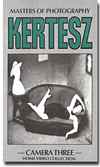 Andre Kertesz
is a 30-minute video from the Masters of Photography series. A fascinating
glimpse of Kertesz in his Washington Square apartment, spreading his images
on the dining room table and talking about how they came into being. A rare
look at one of the masters of photography. (video description courtesy of
International Center of Photography)
Andre Kertesz
is a 30-minute video from the Masters of Photography series. A fascinating
glimpse of Kertesz in his Washington Square apartment, spreading his images
on the dining room table and talking about how they came into being. A rare
look at one of the masters of photography. (video description courtesy of
International Center of Photography)

Annie Leibovitz: Celebrity Photographer is a portrait of the celebrated portrait photographer known for her famous subjects. Annie Leibovitz began her professional career at Rolling Stone and became Vanity Fair's first contributing photographer, and one of the highest paid photographers of our day. VHS/DVD. This 51 minute 1993 program produced by RM Arts; Middlemarch Films from the South Bank Show series, produced for London Weekend Television, contains nudity and explicit language and is directed by Rebecca Frayn.

Ansel Adams is a 100 minute 2002 American Experience PBS Home Video directed by Ric Burns and Narrated by David Ogden Stiers. From Warner Home Video. Ansel Adams's photographs have made him one of the most recognized and admired names in art. A staunch environmentalist, the pictures that Adams took reflected a larger world view the photographer held to strongly.
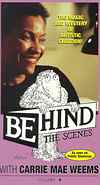
Behind the Scenes Series, Carrie Mae Weems is a 30 minute 1999. video released by First Run Features based on a series by PBS. Presents American photographer Carrie Mae Weems (b. 1953) demonstrating how she decides what to photograph. Discusses how subject matter and composition combine to create meaning in a photograph. The noted photographer, with help from William Wegman, shows how to use composition and content in a photograph. A behind the scenes look. 30-minute video, guide [1]
 Diane Arbus
is a 30-minute video concerning the photographer Diane Arbus. A pivotal
figure in contemporary documentary photography, Diane Arbus produced a substantial
body of work before her suicide in 1971. This portrait features footage
of her lecturing to a small class she held in her apartment and interviews
with her daughter.
Diane Arbus
is a 30-minute video concerning the photographer Diane Arbus. A pivotal
figure in contemporary documentary photography, Diane Arbus produced a substantial
body of work before her suicide in 1971. This portrait features footage
of her lecturing to a small class she held in her apartment and interviews
with her daughter.

Edward J. Steichen is a 1998 Museum of Modern Art by J. Thiltges from Kultur Video. "Considered by many to be the greatest portrait photographer of the 20th Century. He was a major cultural force of the modem age not only photographing prominent figures but reinventing modern fashion and war photography. Silver Award, Houston Film Festival. " (quote from Media for the Arts - www.art-history.com)
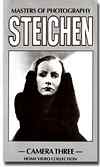 Edward Steichen
is a 30-minute video from teh masters of Photography series. Steichen was
86 in 1964 when he was interviewed for this film. He discusses his unbelievably
long and varied career, including fine art, fashion, portrait, combat, and
aerial photography. (video description courtesy of International Center
of Photography)
Edward Steichen
is a 30-minute video from teh masters of Photography series. Steichen was
86 in 1964 when he was interviewed for this film. He discusses his unbelievably
long and varied career, including fine art, fashion, portrait, combat, and
aerial photography. (video description courtesy of International Center
of Photography)

John Szarkowski: A Life in Photography is a 47-minute video produced by Richard B. Woodward. Checkerboard Foundation, 1998. For nearly 30 years, from 1962-1991, John Szarkowski served as the Director of the Department of Photography at the Museum of Modern Art in New York. This film examines his double life as curator and photographer. Szarkowski, author of the classic "Looking at Photographs," has taught generations how to think about and look at images. (video description courtesy of International Center of Photography)
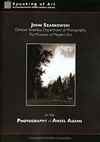
John Szarkowski on the Photography of Ansel Adams is a 47-minute DVD. During his nearly three-decade tenure as Director of the Department of Photography at The Museum of Modern Art, Szarkowski recast the world's thinking about the art of photography. His radically new conception of the medium's possibilities - and its limitations - has influenced critics, historians, theorists, and photographers ever since. In this lecture on Ansel Adams, Szarkowski tackles the deeper significance of Adams' work beyond his enduring popularity as an environmental pioneer and rhapsodist of the American West. (video description courtesy of International Center of Photography)
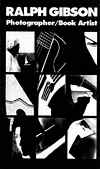 Ralph Gibson
is a 2002 28-minute video. For more than thirty years Ralph Gibson has served
as one of the few truly independent forces within the art of photography.
In this video biography, Gibson discusses his life and is forthcoming about
what, why and how he shoots, the editorial decisions that dictate the laying
out and putting together of his books, and the crucial point when he knows
if a body of work is or is not complete.
Ralph Gibson
is a 2002 28-minute video. For more than thirty years Ralph Gibson has served
as one of the few truly independent forces within the art of photography.
In this video biography, Gibson discusses his life and is forthcoming about
what, why and how he shoots, the editorial decisions that dictate the laying
out and putting together of his books, and the crucial point when he knows
if a body of work is or is not complete.

Roots of California Photography: The Monterey Legacy, The was produced and directed by Steven Rosen and Terri De Bono of Mac and Ava Motion Pictures. Script written by Steven Hauk. Photographers included are Edward, Brett and Cole Weston, Wynn and Edna Bullock, Ansel Adams, Morley Baer, Henry Gilpin, John Sexton, Richard Garrod, Sonya Noskowiak, Margrethe Mather, Ruth Bernhard, among others.
 Walker Evans: America, is a 57-minute profile of the great American photographer, Walker
Evans, the first photographer to have a one-man retrospective at the Museum
of Modern Art. This video contains rare interviews with Evans himself, recorded
in the late 1960's. (video description courtesy of International Center
of Photography)
Walker Evans: America, is a 57-minute profile of the great American photographer, Walker
Evans, the first photographer to have a one-man retrospective at the Museum
of Modern Art. This video contains rare interviews with Evans himself, recorded
in the late 1960's. (video description courtesy of International Center
of Photography)
Andre Kertesz: 30 minutes 1989 "Andre Kertesz, "the father of 35 millimeter photography," was born in Hungary in 1894 and lived in the Paris of the 1920s and 1930s before emigrating to the United States just before World War II. Long before every home had a camera, his work embodied the spirit of what the world now calls candid photography: personal, mobile, unposed. This documentary presents Kertesz in his own words, explaining his pictures and sharing his memories -- provincial life in Hungary, central Europe in World War I, famous friends like Colette, Einstein, Chagall, and Mondriaan, and details of the poetry of human life."[1] Also titled Everything Is Photograph: A Profile of Andre Kertesz from Camera Three Productions
Ansel Adams, Photographer 60 minutes "This film captures the spirit and artistry of the man as he talks about his life and demonstrates the techniques that have made his work legendary. As Adams talks of the country he loves, viewers glimpse his photographs juxtaposed with the landscapes he photographed. In a conversation with artist Georgia O'Keeffe, Adams discusses his association with her husband, pioneer photographer Alfred Steiglitz." "Outlines the long and prolific career of American photographer Ansel Adams (1902-1984) as an artist, conservationist, and teacher. Follows him to the locations of his most famous photographs, including Yosemite." [2] By John Huszar. 1986 (available through Las Positas College Library)
Dorothea Lange: American Photographer is a 13 minute, PPR 1988 video. "Trained as a portrait photographer in San Francisco, Dorothea Lange (1895-1965) abandoned her studio in the 1930s and began documenting the effects of the Depression on ordinary Americans. Her images spoke eloquently of the plight of the poor and brought the desperation of the Depression into the consciousness of the public. Her last exhibition, a retrospective held at the Museum of Modern Art in 1965, was a tribute to the human face. Lange's photographs remain singular symbols of America's 'Dust Bowl' era."
Dorothea Lange: A Visual Life is a 50 minute 1995 film directed by: Meg Partridge. The great photographer is revealed through examples of her work and interviews with both the artist and her family. Lange was pivotal to the development of documentary photography traditions and her work remains an aesthetic achievement that continues to inspire photographers today. "A tapestry of candid, often conflicting insights into the photographer Dorothea Lange's life and art. Lange reveals her philosophical approach to photography, her passion for her medium and the conflicts in her work and family life. We are taken into Lange's confidence as she strives to maker photographs emotionally charged as well as historically accurate. The result is an engaging portrait of this extraordinary and complex visual artist." (Arkansas Humanities Council)
Photography in 19th-Century America Traces the development of photography in the U.S. from the introduction of daguerreotypes in 1839 through the invention of the Kodak camera by George Eastman in 1888. 23-minute video. Description source: Amon Carter Museum
Richard Avedon, Darkness and Light Profiles American photographer Richard Avedon (b.1923) through interweaving extensive interviews with himself, his family, friends, and clients. Includes photographs from every phase of his career 87-minute video. Description source: Amon Carter Museum
This Is Edward Steichen: 25 minutes 1965. "This film includes examples of Edward Steichen's masterful photographs and a warm, personal interview with the 86-year-old photographer in his Connecticut home. He expresses his feelings about painting and photography and describes his recollections about meeting and photographing such great figures as Auguste Rodin and Greta Garbo."
Time Exposure: William H. Jackson, Picture Maker of the Old West Presents photographs of the American West including mountains, railroads, and mining towns made during the late 19th century by photographer William Henry Jackson (1843--1942). Reenacts demonstrations of glass-plate photography, developing, and solar printing. Narrated by actor Burgess Meredith. 26-minute video. Description source: Amon Carter Museum
rev. 8/22/05
Links to sources of information outside of our web site are provided only as referrals for your further consideration. Please use due diligence in judging the quality of information contained in these and all other web sites. Information from linked sources may be inaccurate or out of date. TFAO neither recommends or endorses these referenced organizations. Although TFAO includes links to other web sites, it takes no responsibility for the content or information contained on those other sites, nor exerts any editorial or other control over them. For more information on evaluating web pages see TFAO's General Resources section in Online Resources for Collectors and Students of Art History.
Read more articles and essays concerning this institutional source by visiting
the sub-index page for the Museum of
Fine Arts, Houston in Resource Library.
Search for more articles and essays on American art in Resource Library. See America's Distinguished Artists for biographical information on historic artists.
This page was originally published in 2003 in Resource Library Magazine. Please see Resource Library's Overview section for more information.
Copyright 2012 Traditional Fine Arts Organization, Inc., an Arizona nonprofit corporation. All rights reserved.